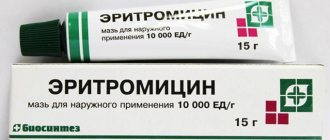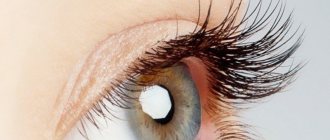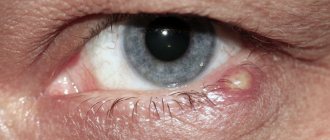Eye inflammation
The outside of the eye is covered with a thin mucous membrane - the conjunctiva. Its main function is protective:
- secretion of the mucous component of tear fluid;
- participation in the blood supply to the cornea;
- synthesis of immunoglobulins;
- initiation of an inflammatory reaction when foreign particles enter the eye, incl. viruses and bacteria.
The conjunctiva begins at the edges of the upper and lower eyelids and passes through the back wall of the eyelid to the surface of the eyeball towards the cornea. The average thickness of this shell is 0.3 mm. It consists of flat epithelium, a large number of blood vessels, auxiliary lacrimal glands and goblet cells that secrete mucus.
According to the authors of the practical medical manual “Conjunctivitis”, diseases of the mucous membrane make up more than a third of all eye diseases. In southern countries, where infectious epidemics are common, this proportion is even higher.
Inflammation of the conjunctiva, expressed in redness and swelling of the mucous membrane, swelling and itching of the eyelids, sometimes with purulent discharge and the formation of follicles, is called conjunctivitis.
Causes
By prevalence:
- Infectious;
- Allergic;
- Mechanical or toxic.
Infectious inflammations occur most often because they are caused by both external pathogens and microbes that live in the conjunctival sac: staphylococci, pneumococci, xerosis bacilli. When immunity decreases, microorganisms actively multiply in the mucous membrane, which leads to disease.
The classification of conjunctivitis by etiology is given in the table.
| Type | Kinds | Varieties | Contagiousness |
| Infectious | Bacterial |
| Yes |
| Viral |
| Yes | |
| Chlamydial |
| Yes | |
| Fungal | — | Yes | |
| Acanthomoeba keratoconjunctivitis | — | Yes | |
| Allergic |
| — | No |
| Mechanical or toxic |
| — | No |
According to the duration of the course and the frequency of manifestations, acute and chronic conjunctivitis are distinguished; according to the degree of eye damage - unilateral and bilateral processes.
Symptoms
The disease is characterized by:
- hyperemia of the conjunctiva and eyelids – “rabbit eyes”;
- swelling of the eyelids;
- itching;
- lacrimation;
- irritation or sensation of a foreign object – “sand in the eye”;
- mucous discharge - in case of a viral or allergic disease;
- purulent discharge - with bacterial inflammation;
- follicles - in severe cases;
- photophobia – sometimes;
- fever - with an infectious etiology, most often in children.
Conjunctivitis does not require treatment in a hospital, but some types of it are highly contagious and spread quickly in groups, for example, in a kindergarten. It is recommended to treat the disease at home, avoiding contact - the infectious type may join the allergic type due to external pollution and weakened immunity.
Delayed diagnosis or improper treatment leads to complications and transition to a chronic form. Inflammation of the conjunctiva, like any ophthalmological disease, can cause other pathological processes, incl. progression of refractive error in children.
Diagnostics
Clinical protocols of the Ministry of Health of the Republic of Kazakhstan-2014 recommend the following methods:
- taking anamnesis;
- biomicroscopy;
- assessment of visual acuity;
- physical examination;
- culture of discharge from the conjunctiva;
- microscopic examination of a smear;
- fluroscein staining.
Diagnosis and treatment are carried out by an ophthalmologist. Additionally consult:
- Allergist and TB specialist - to clarify the etiology of the disease;
- Combustiologist – for chemical burns of the conjunctiva;
- Venereologist – for gonococcal and chlamydial conjunctivitis.
In differential diagnosis, symptoms of inflammation of the mucous membrane are distinguished from manifestations of other ophthalmological diseases, which are also accompanied by swelling, pain and injection of the conjunctiva:
- dry keratoconjunctivitis;
- blepharitis;
- iridocyclitis;
- acute attack of glaucoma.
Analogs
Analogues of the active substance (tetracycline) include semisynthetic derivatives of oxytetracycline: metacycline and doxycycline.
The next generation of tetracycline was:
- morphocycline;
- glycocycline.
Below are analogues of tetracycline ointment, similar in composition:
Tobrex
The main active ingredient is tobramycin. This drug is a broad-spectrum antibiotic and belongs to the group of aminoglycosides. It has a bacteriostatic and bactericidal effect. Prescribed for conjunctivitis, iridocyclitis, keratitis, blepharitis, blepharoconjunctivitis, keratoconjunctivitis. Used to prevent complications during the postoperative period in ophthalmology.
Contraindications include childhood and hypersensitivity to the drug. Side effects occur rarely, in the form of allergies, which are accompanied by swelling of the eyelids, itching, and conjunctival hyperemia.
After using this medication, it is not recommended to work with heavy machinery or drive a car.
Dexa-gentamicin
The active components are dexamethasone and gentamicin sulfate. The combined agent has antiallergic, antibacterial and anti-inflammatory effects. It is used for the treatment of allergic manifestations that are accompanied by bacterial infection, acute infections (blepharitis, conjunctivitis, barley, keratitis), as well as for the treatment and prevention of inflammation in the postoperative period.
It is not recommended to use this drug if:
- mycobacterial infections;
- corneal epitheliopathy;
- dendritic keratitis;
- high intraocular pressure;
- fungal infections of the visual organ;
- purulent eye diseases;
- individual intolerance to the components of the medication.
Side effects such as burning or itching may occur. Dexa-gentamicin is not recommended for use immediately before driving.
Hydrocortisone ointment
It has an anti-inflammatory and anti-exudative effect, and also eliminates swelling and itching. Prescribed for the treatment of neurodermatitis, psoriatic lesions, seborrhea, contact and allergic dermatitis, various forms of eczema, lichen planus verrucous, as well as diseases of the eyelids (conjunctivitis, dermatitis, blepharitis, keratoconjunctivitis).
The drug should not be used for the following conditions:
- perioral dermatitis;
- syphilis rashes;
- tuberculosis of the skin and eyes;
- trachoma;
- skin cancer;
- viral, bacterial, fungal infections on the skin and visual organ;
- violations of the integrity of the epithelium of the eyes or skin (abrasions, ulcers, wounds);
- in the period after vaccination;
- children under 2 years of age.
Side effects include:
- from the visual system - deterioration or loss of visual function, increased intraocular pressure, cataracts;
- on the part of the skin – stretch marks, hemorrhage, atrophy, acne.
Levomycetin
The active ingredient is chloramphenicol (levomecithin). The drug has antibacterial properties. Prescribed for the treatment of eye diseases such as blepharitis, keratitis, conjunctivitis, trachoma, blepharoconjunctivitis, keratoconjunctivitis, barley.
And also for the treatment of the following skin pathologies:
- bacterial eczema;
- dermatoses;
- thermal or chemical burns;
- boils;
- bedsores;
- necrosis and suppuration of the skin.
It is prohibited to use this drug in children under 1 month of age, with intolerance to chloramphenicol or other components, as well as with certain diseases:
- liver or kidney dysfunction;
- insufficient hematopoiesis;
- diseases of the circulatory system;
- acute intermittent porphyria;
- eczema, psoriasis, fungal infections of the skin;
- oncology.
Erythromycin ointment
The active ingredient is erythromycin. Pharmacological properties of the drug: anti-acne, antibacterial. Indications for the medicine include: second and third degree burns, furunculosis, keratitis, barley, trachoma, conjunctivitis, chlamydia, trophic ulcers, bedsores.
Contraindications to this ointment include individual intolerance to the substances that make up its composition.
Side effects may include an allergic reaction in the form of hyperemia or itching.
The antibiotic in question should be used only after carefully studying the instructions. In case of serious pathologies, a medical prescription is necessary.
Instructions for use
Tetracycline ointment is used topically. Oral use is prohibited; it will cause dyspeptic reactions (nausea, vomiting, change in stool). The thick form is used for the area of the conjunctival sac and eyelids.
To achieve maximum effect, the drug is used prolonged. Therefore, it is used before bedtime. It accumulates in the tissues of the eyelids and conjunctival sac, causing long-term destruction of pathogenic microorganisms.
Squeeze the contents of the bottle onto a cotton swab the size of half a pea.
It is applied to the affected eye area depending on the disease:
- outer side of the eyelid;
- inner side of the eyelid;
- inner corner of the eyes with conjunctivitis;
- skin around the eyes.
If the inner area of the eyelids and eyes is affected, the drug is applied directly from the tube to the mucous membrane, retracting the lower eyelid. After use, clouding occurs and a temporary decrease in visual acuity occurs.
If the drug is prescribed during the day, the use of lenses should be temporarily discontinued. The agent will accumulate in the structure of the contact lenses, causing their damage. The duration of therapy is determined by the doctor during the examination. Most often the period is 1-2 weeks. With trachoma, the period increases to two months. For severe trachoma, the drug is used for more than 3 months.
If the patient has a mild or moderate disease, the drug is prescribed once a day before bedtime. If the disease is more serious, the time intervals are reduced. The product is applied every 2-4 hours. This will prevent the increased proliferation of pathogenic microflora.
For children
There have not been sufficient trials on the use of tetracycline ointment in children. Pediatricians believe that the drug can be used from 1 year of life if the benefits from it exceed the possible side effects.
Composition and description of the drug
Tetracycline is a broad-spectrum antibiotic. It is the active ingredient of tetracycline ointment. Depending on the amount of active substance, there are 1% and 3% preparations. The yellowish-colored substrate with a specific odor is packaged in tubes of different weights - 5 g, 10 g, 30 g and 50 g.
Tetracycline ointment is freely available over-the-counter in pharmacies, but this does not mean that a pregnant woman can use it without a doctor’s prescription.
Tetracycline ointment during puberty
Experts prescribe tetracycline to adolescents when acne, pimples and boils appear on the face. This drug copes well with teenage problems, which are not always amenable to even expensive, advertised remedies.
Where else is tetracycline used?
Tetracycline ointment is an affordable remedy, so it is used in many branches of medicine. Including burn therapy. This is where the most common cases are when patients develop purulent inflammation against the background of open wounds after burns.
IMPORTANT!!! The drug in burn therapy is used only in cases of bacterial infection. In its absence, prescribing tetracycline to the patient is not necessary.
Equally important, tetracycline hydrochloride is often used to treat hemorrhoids. In particular for bleeding hemorrhoids
In such cases, there is a risk of infection (for obvious reasons). Therefore, the use of Tetracycline ointment is recommended!
ENT practitioners also quite often resort to tetracycline therapy. Since diseases of the human hearing system are almost always accompanied by a bacterial infection. However, you should not have high hopes when introducing the product into the ear canal. It is also necessary to use drugs that will act inside the body, being absorbed into the bloodstream.
Pharmacological group
According to its properties, Tetracycline ointment belongs to the group of antimicrobial medications with a wide spectrum of antibiotic effects. Tetracycline hydrochloride inhibits the growth and reproduction ability of a number of pathogenic microorganisms. The mechanism of the bacteriostatic action of the drug is to prevent the formation of complex compounds between the ribosome and the transfer RNA of the bacterial cell. This effect contributes to the cessation of intracellular protein synthesis and inhibition of the biological activity of microorganisms.
The medication has pronounced therapeutic properties in the treatment of dermatological diseases caused by the following pathogenic microflora:
gram-positive: staphylococci (Staphylococcus spp.), streptococci (Streptococcus spp.), Haemophilus influenza, listeria (Listeria spp.), anthrax bacillus (Bacillusanthracis);
gram-negative: gonococcus (Neisseria gonorrhoeae), Treponema pallidum (Treponema spp.), pertussis (Bordetella pertussis), E. coli (Escherichia coli), enterobacteria (Enterobacter spp.), Klebsiella spp., salmonella (Salmonella spp.) , shigella (Shigellaspp.), rickettsia (Rickettsia spp.), chlamydia (Chlamydia spp.), mycoplasma (Mycoplasma spp.).
Tetracycline hydrochloride does not have an antibiotic effect against fungi, some strains of bacteroides, viruses, group A hemolytic streptococci, Pseudomonas aeruginosa, Serration and Proteus mirabilis due to the developed resistance of these microorganisms to the action of the drug.
Due to the fact that Tetracycline ointment has an exceptional local therapeutic effect and practically does not penetrate into the systemic circulation, the pharmacokinetic properties of the drug have not been studied.
Is it possible to use Tetracycline ointment during pregnancy?
The use of tetracycline ointment by women during pregnancy is permissible, but only if the benefit is significantly higher than the potential threat to the fetus. Most often, the drug is prescribed for bacterial conjunctivitis.
Such outbreaks in women in an interesting position against the background of weakened immunity and unstable hormonal levels are not uncommon.
But if an eye disease is suspected, women are advised to first undergo a culture test.
It is important to identify the pathogen and check the degree of its sensitivity to the tetracycline antibiotic so that the drug brings therapeutic benefit. When prescribing a course of treatment, the doctor takes into account the duration of pregnancy, since at the initial stage in the first trimester many drugs and especially antibiotics are prohibited due to the formation of organs in the fetus that are at the stage of formation
When prescribing a course of treatment, the doctor takes into account the duration of pregnancy, since at the initial stage in the first trimester many drugs and especially antibiotics are prohibited due to the formation of organs in the fetus that are at the stage of formation.
It is allowed to use ointment (3%) in the 2nd trimester of pregnancy, but under the supervision of a doctor. In the 3rd trimester of pregnancy, the use of tetracycline is undesirable, since the active substances can have a rather aggressive effect on the fetus during the formation of the bone skeleton and structures.
Can Tetracycline ointment be used during pregnancy?
Tetracycline ophthalmic or external ointment is recommended by a doctor for pregnant women in extreme cases. It is prescribed if a woman has a history of pathologies that only this drug can eliminate:
- ophthalmological diseases;
- bacterial skin infections.
Before prescribing the ointment, it is necessary to inoculate a biological sample in a nutrient medium. The study helps to establish the species of the infectious pathogen and its sensitivity to antibiotics. If only tetracycline can destroy bacteria, then pregnant women are prescribed ointment in the lowest concentration.
In what cases is the drug prescribed to pregnant women?
During pregnancy, a doctor may prescribe tetracycline ointment to treat infectious inflammation of the eyes:
- bacterial conjunctivitis;
- blepharitis;
- barley.
If the patient develops a bacterial or fungal infection due to an exacerbation of herpes, a tetracycline-based remedy can also be used.
To minimize undesirable effects on the fetus, a 1% preparation is used for application to the skin.
Manifestations of herpes and pregnancy are interrelated. During the period of bearing a child, the body's defenses weaken, which contributes to the activation of viruses.
Effect of the drug on the fetus
The antibiotic tetracycline is not used to treat pregnant women due to its teratogenic effects on the fetus. The drug easily penetrates all biological barriers, including the placenta. A significant amount of the drug accumulates in fetal tissues:
- bone;
- articular;
- cartilaginous.
The result is their demineralization, or excessive fragility. Improper bone formation causes various congenital pathologies of the child’s musculoskeletal system.
Indications for use
Local antibiotic Tetracycline is widely used in various fields of medicine. It helps against any pathologies of the skin and mucous membranes caused by bacteria susceptible to its influence. What is eye ointment indicated for? The main medical prescriptions are inflammatory processes:
- trachoma;
- barley;
- microbial conjunctivitis.
A drug with an active substance concentration of 3% promotes rapid healing of wounds and abrasions that have become infected. By destroying bacteria, inflammation is eliminated, and tissue epithelization processes are enhanced.
A medicine such as Tetracycline Akos ointment is used to treat pimples and acne. Acne is most often associated with the development of an infection on the skin, which the antibiotic successfully fights. The ointment will also help with complicated forms of acne, which are caused by the appearance of multiple pimples, ulcers, and areas of redness. For boils and carbuncles, the product will help destroy bacteria that cause the pathology.
As a prophylactic drug, Tetracycline can be used for eczema (if there is a risk of infection of the wounds), as well as for herpes. The medicine does not affect viruses, but does not allow the infection to invade new areas of the skin of the lips and genitals. In gynecology, ointment is prescribed to treat inflammation of the vagina and external genitalia.
Indications for the use of tetracycline ointment during pregnancy
Tetracycline ointment (external or ophthalmic) is a broad-spectrum antibiotic that inhibits the growth of pathogenic microflora in the inflamed area. Available in tubes containing 3% and 1% active substance. The drug acts locally on the affected area of the skin or mucous membrane and practically does not enter the human circulatory system. The drug is not used to treat fungi and viruses due to bacterial resistance to the active substance tetracycline.
External ointment 3% is prescribed for the treatment of the following infectious infections in a patient:
- acne, acne;
- eczema with associated infection;
- furunculosis, folliculitis.
Eye ointment 1% is used in ophthalmology to treat:
- conjunctivitis;
- barley, inflammation of the mucous membrane of the eye;
- lesions of the edges of the eyelids (blepharitis).
Indications for use
The product is used taking into account the characteristics of the effect of the antibiotic included in its composition on the body.
Tetracyclines are a group of semi-synthetic and synthetic substances belonging to polyketides. Antibiotics of this type have a bacteriostatic effect, that is, they prevent the proliferation of harmful microorganisms. Bacteria are deprived of the ability to reproduce and grow, and therefore are easily eliminated by the human immune system.
Skin treatment
Tetracycline ointment helps with acne, which affects most teenagers. It is effective for secondary bacterial infections, abscesses (abscesses), trophic purulent ulcers and other diseases:
In addition, Tetracycline ointment is effective for the following diseases:
- Streptoderma is a purulent inflammation of the skin as a result of bacterial damage. With this disease, red spots appear on the skin, which then turn into watery blisters filled with cloudy-whitish contents. Subsequently, they burst and become covered with crusts, causing severe itching.
- Folliculitis is an infectious inflammation that affects the hair follicles. First, a small nodule forms near the follicle, which then transforms into a small abscess.
- Phlegmon - looks like a large abscess, but does not have clear boundaries. When touching the affected area of skin, the patient feels pain.
- Dermatitis of infectious etiology.
- Furunculosis.
- Herpes.
- Other inflammatory processes of subcutaneous tissue with purulent contents.
- Postoperative infections.
Application in ophthalmology
For eye infections, the product is placed under the lower eyelid 3-5 times a day. If the patient wears contact lenses, they must be removed before using the medicine. Tetracycline ointment is used for diseases such as:
- blepharitis - inflammation of the edges of the eyelids;
- trachoma is an infectious disease of the connective membrane of the eye caused by chlamydia;
- conjunctivitis - infection of the outer shell of the eye;
- meibomite (barley);
- keratitis;
- other infectious eye lesions.
When applying the cream, do not touch the mucous membranes of the eye with the tip of the tube.
Tetracycline ointment - instructions for use
Naturally, instructions for using Tetracycline ointment are included with the drug itself, but often the tube is stored separately from the packaging, and it is lost or thrown away. It would not be superfluous to clarify the method and indications for use, and the features of the drug. The ointment is used for infectious or bacteriological diseases of the skin, mucous membranes, and eye infections such as:
- acne;
- streptostaphyloderma;
- furunculosis;
- folliculitis;
- infected eczema;
- trophic ulcers;
- blepharitis;
- unspecified conjunctivitis;
- trachoma;
- chlamydial eye infections.
The drug is applied pointwise to the affected area 1-2 times a day until complete recovery, and not just the disappearance of the lesion. Sometimes, for large areas of the disease, tetracycline-based bandages or lotions are used. Any use of medications must be agreed with the treating specialist. If unusual symptoms occur after application, you should immediately stop using and consult a doctor. Shelf life after opening the tube is no more than 2-3 months.
For children
The use of Tetracycline ointment for children under 8-11 years of age is extremely undesirable, because studies of contraindications and full effects have not been conducted
The doctor may prescribe the drug to the child, but it is important to carefully monitor possible side effects. It is strictly undesirable to use the ointment on infants under 1 year of age and during teething.
If the drug is still prescribed, then you need to use a 1% version of it, which is less aggressive and not supplemented with secondary active substances.
During pregnancy
According to the instructions for use, tetracycline is contraindicated during pregnancy and lactation. The substance penetrates the placental barrier, causing slower bone growth and fetal pathology. The medicine is prescribed in rare cases and for a short period of treatment. Recently, on some women's forums, on the contrary, tetracycline is aggressively recommended, since it is stated that “an ointment placed behind the eyelid for conjunctivitis cannot get into the fetus.” This is basic illiteracy, which also carries danger.
Tetracycline ointment during pregnancy: features of use
While waiting for a baby, a woman becomes more vulnerable. Tetracycline ointment during pregnancy may be useful in the following cases:
- Infectious eye diseases. Typically, women are faced with conjunctivitis, stye, keratitis or blepharitis, and these diseases can bother the patient several times during pregnancy.
- Skin diseases. This includes diagnoses such as streptoderma, folliculosis and folliculitis and other diseases that can lead to purulent abscesses.
- Eczema.
- Trophic ulcer. Your doctor may prescribe antibiotics if the skin condition remains persistently poor (unhealing wound) for at least 6 weeks.
Some pregnant women, having all the indications for it, still refuse to take tetracycline ointment. It is extremely unwise to do this, because the consequences of lack of therapy can be much higher than the possible harm to the fetus during treatment. In other words, prescribing an antibiotic is a justified measure that should not be feared. The main thing is that such an appointment is made by a specialist - the attending physician.
Effect of the drug on the fetus
What exactly are the risks of using tetracycline ointment during pregnancy? This antibiotic changes the bone structure of tissues. It disrupts the natural process of mineralization of the fetus growing in the womb. This can lead to congenital pathologies of the baby’s musculoskeletal system.
For this reason, the use of the drug is undesirable in the 3rd trimester of pregnancy. To minimize risks, the doctor may recommend that the patient reduce the traditional frequency of use during the day (no more than 3 times a day) or use a 1% composition.
Before starting ointment therapy, familiarize yourself with the composition and indications for the product.
Composition and description of the drug
The main active ingredient is the substance of the same name – tetracycline. This is an antibiotic from the tetracycline group, which has been used in human therapy for just over half a century.
It was isolated from special radiant fungi a little later than penicillin, and is now quite well studied.
Artificial additional components in the composition of drugs only enhance the effect of tetracycline.
Tetracycline has a number of advantages over antibacterial agents of other groups. In particular, it has a wide range of effects, which means its use can destroy various bacteria. The mechanism of action is as follows.
Tetracycline blocks the protein synthesis of pathogens, and the reproduction and further spread of the microbe stops. The inflammatory process is quickly eliminated. Tetracycline drugs are most effective when affecting mucous membranes, skin and joint tissues.
This means that when applying the product to the eye tissue, you can expect a good therapeutic result.
Since tetracycline ointment works well specifically on superficial tissues, it can be used topically, bypassing the systemic circulation. This is especially important during pregnancy, since it is with the bloodstream that parts of all medications used by a woman are carried into the body of the growing fetus through the placenta.
By the way, taking tetracycline orally for a long time, one can notice its accumulation in growing bone tissue and teeth, which subsequently provokes processes of their destruction.
Indications
Indications for the use of tetracycline ointment are very wide. Among them are ophthalmological, skin and other diseases:
- conjunctivitis;
- barley;
- streptoderma;
- acne;
- burns;
- trophic ulcers;
- boils;
- trachoma;
- keratitis;
- blepharitis of an infectious nature;
- staphyloderma.
It is very important that all diseases assume a bacterial etiology. If the reason is the activation of a virus or fungal pathogen, or the person has an inflammatory allergic process, then tetracycline ointment will not have the desired therapeutic effect.
It would be better if, before starting therapy, the doctor prescribes the patient the appropriate tests (bacterial culture) to identify the pathogen. Otherwise, there is a possibility that the drug will be ineffective for a viral infection, or the patient may have resistance (insensitivity) to this type of antibiotic.
In general, tetracycline drugs are not considered very dangerous and harmful, and therefore they are used even in the youngest patients - newborn babies.
Contraindications and side effects
There are a number of conditions and diagnoses for which the use of tetracycline ointment is not recommended:
- leukopenia;
- individual intolerance to a component of the drug;
- liver failure;
- mycoses;
- pregnancy and lactation (limited use);
- The patient's age is under 18 years.
The last point should be discussed in more detail. This antibiotic can cause irreversible changes in the bone structure, which can be critical for a growing child’s body.
In some cases, pediatricians still prescribe tetracycline ointment to young patients, however, it is recommended to use products with a reduced content (1% instead of drugs with a standard concentration of 3%).
Side effects may also occur during tetracycline therapy. In addition to traditional itching, burning, redness and swelling, the patient may experience digestive disorders (indigestion, diarrhea, constipation), loss of appetite, photosensitivity, dysphagia and Quincke's edema. Of course, these cases are quite rare, but their occurrence cannot be completely ruled out, especially in pregnant women.
Long-term therapy with tetracycline ointment can lead to candidiasis, deficiency of B vitamins, and thrombocytopenia.
Why is it likely that a fungal infection will develop during treatment with tetracycline? Exposure to the antibiotic weakens local immunity, and fungal pathogens that are present on the skin and were previously dormant begin to become active.
How to replace Tetracycline
If it is necessary to use antibiotics, the doctor may prescribe drugs from other groups:
- Tobrex. Tobramycin in its composition well suppresses the activity of Pseudomonas aeruginosa and Escherichia coli, staphylococcus, streptococcus and a number of other most common pathogens. When used topically, the components of the drug do not enter the bloodstream, and therefore are indicated for use by pregnant women and women during lactation. The cost of a 5 ml bottle of the drug is approximately 200 rubles.
- Dexa-gentamicin. This is a complex drug created on the basis of several active substances. Gentamicin is an antibiotic of a number of aminoglycosides. It shows good activity against most pathogens (with the exception of staphylococcus). Dexamethasone helps reduce inflammation and relieve itching. The manufacturer indicates that the drug should not be used in the 1st trimester of pregnancy.
- Albucid. Sulfacyl sodium in its composition is not an antibiotic, although it exhibits antimicrobial activity. It is not prohibited for local use for indications during pregnancy, but in the later stages its use can cause problems with the functioning of the liver in the expectant mother. This is the most affordable drug. At the pharmacy, a bottle with a capacity of 10 ml will cost the patient no more than 50 rubles.
Tetracycline ointment is a good germ suppressant that can even be used by pregnant women. The main thing is to follow the therapeutic regimen prescribed by your doctor and inform him about your condition during treatment.
Attention: antibiotic!
Tetracycline is an antibiotic, therefore, despite its external use, it is necessary to approach the treatment correctly and consider the possible pros and cons. Like any other antibacterial drug, if used incorrectly it can cause harm.
Therefore, we focus on a number of factors that need to be taken into account when choosing a product:
- The ointment is a local treatment preparation. It almost does not penetrate into the systemic bloodstream and does not have a general effect on the entire body. Despite this, tetracycline ointment should not be used during pregnancy in the 1st trimester. There is a possibility of penetration of a small amount of tetracycline through the placenta, disrupting the development of the fetus.
- The ointment is not used in the treatment of infants, nurseries, kindergarten and primary school children. Tetracycline ointment is not used for children 2 years old, 5 years old. It can only be used to treat older children. At what age can the composition be used according to the instructions? Treatment of children with tetracycline is permitted after 11 years of age.
Contraindications and side effects
Like any medicine, tetracycline ointment has a number of contraindications.
It is strictly prohibited:
- when large areas of skin are affected by fungi;
- with a low level of leukocytes in the blood;
- for some diseases of the gastrointestinal tract;
- in case of liver failure;
- if the patient is allergic to the components of the ointment.
The simultaneous use of tetracycline ointment with certain drugs reduces its therapeutic properties. Therefore, simultaneous use with medications of a number of penicillins, antacids, retinol, and metal ions is undesirable.
Note: how to use Elidel during pregnancy.
All about what vitamins and minerals are included in the Emfetal complex.
When applying tetracycline ointment, side effects may occur:
- allergic rashes, urticaria, swelling;
- intolerance to bright light;
- when used for a long time – darkening of teeth;
- fungal infection (candidiasis).
If side effects occur, you should immediately stop using tetracycline ointment during pregnancy to avoid negative consequences and report them to your doctor.
Pregnancy is a special time in the life of every woman; during this period it is very important to closely monitor your well-being, do not hesitate to contact doctors, ask about treatment methods, prescribed medications, and use additional sources of information.
What does it consist of and how does it work?
The active substance of Tetracycline is the component of the same name, tetracycline. The preparation intended for ophthalmological diseases contains 10 mg per 1 g (1%). This is an antibiotic with a bacteriostatic effect. It blocks the functions of pathogenic microorganisms and stops their reproduction by disrupting protein biosynthesis (the most important process necessary for life) in pathogen cells. The ingredient is active against the following types of bacteria:
- gram-positive (retain color when stained using the Gram method, have a single-layer cell membrane structure) - streptococci, staphylococci;
- gram-negative (change color when washed using the Gram method, unlike gram-positive bacteria, have an outer membrane) - Escherichia coli, chlamydia, bordetella, salmonella, klebsiella, shigella, etc.
Tetracycline also effectively fights many fungi and viruses.
Some microorganisms are resistant to the action of the antibiotic. Therefore, only a doctor can prescribe an ointment after determining the etiology (that is, origin) of the disease.
In addition to the active ingredient, the medicine also contains auxiliary substances necessary mainly for the formation of its form - petroleum jelly and anhydrous lanolin.
Tetracycline eye ointment has the following effects:
- antibacterial;
- antiseptic;
- anti-inflammatory;
- mild pain reliever;
- emollient.
The product begins to work within an hour after application and continues to act for about 2 days.
The medicine is usually well tolerated by patients of all ages. Its use does not cause pain. Tetracycline is absorbed into the systemic circulation in minimal quantities, and yet systemic side effects cannot be ruled out (more on this below).
Analogs
- Ditetracycline eye ointment has a prolonged effect (up to 72 hours), since its main component (detetracycline) is absorbed into the blood gradually. The drug is prescribed to combat sluggish chronic infections that have been resistant to treatment for a long time. The convenience of using this medicine is that it is placed in the eye once a day. The drug costs 120-145 rubles.
- Colbiocin, a multicomponent medicine. The drug includes not only tetracycline, but also other antimicrobial substances: chloramphenicol and sodium colistimethate. The ointment is indicated for conjunctivitis, blepharitis, keratitis and corneal ulcers. You can buy Colbiotsin for 270-390 rubles.
- Tobrex (0.3%) is an ophthalmic agent based on the aminoglycoside - tobramycin. It is a bactericidal drug that actively destroys bacterial colonies. The cost of the medicine is 190-240 rubles.
- Hydrocortisone ointment 2.5% has a pronounced antipruritic, anti-edematous, and anti-inflammatory effect. It effectively combats the manifestations of eye pathologies, but does not eliminate their cause. The price of the medicine is 70-90 rubles.
What is tetracycline ointment used for and what does it help with?
Tetracycline eye ointment is based on tetracycline (1%), an active component with a complex chemical formula, often used in pharmaceuticals under the name trihydrate, hydrochloride. This drug in its pure form is a yellow crystalline powder, bitter in taste and poorly soluble in water.
But it is quite easily susceptible to acids and alkalis. The medicine will provide quick help for damage to the organ of vision caused by conditionally pathogenic microflora (mycosis, fungi, chlamydia, rosacea).
Main indications for use:
- conjunctivitis with inflammatory flow of the conjunctiva with purulent discharge from the eyes;
- keratitis as a consequence of infectious damage to the ocular cornea;
- myositis with inflammation of the glands located in the tissues under the upper eyelids of the eyes;
- trachoma in case of infection, swelling of the tissues of the eyeball caused by chlamydia;
- bacterial blepharitis with inflammation of the eyelids.
Tetracycline eye ointment has an anti-inflammatory, regenerating effect, so it can be used externally for various skin lesions:
- acne;
- burns (regardless of etiology);
- furunculosis;
- eczema;
- acne;
- streptoderma;
- staphyloderma.
The medicine is suitable for prevention in case of accidental contact of debris or dust in the eyes in order to avoid accidental infection due to bruises and paresis.
This antibiotic suppresses bacterial flora well. But it is prescribed directly by an ophthalmologist based on the results of diagnostics and fundus examination.
Tetracycline eye ointment (1%) is indicated exclusively for diseases caused by bacteria. If a viral infection develops, for example, herpes on the lip, the use of the drug may become completely useless.
It is acceptable to use tetracycline ointment (3%) for external use in the treatment of colds on the lip and skin diseases with a purulent course. However, before use, it is recommended to first consult with your doctor.
Tetracycline ointment can be used only for external purposes, surface treatment of the skin and eyes. You need to apply the ointment under the eyelid according to the instructions. The active substance in the composition can stop the life and reproduction of bacteria and disrupt their protein synthesis. In particular, the ointment has a good effect on other representatives of pathogenic microflora. But today new strains of bacteria have been identified that are quite resistant to tetracycline drugs, so this drug may become practically ineffective.
Is tetracycline ointment safe during pregnancy?
In anticipation of the baby, the body of the expectant mother is weakened and more susceptible to various diseases. During pregnancy, it is necessary to be especially responsible in the selection of medications, including antibiotics, such as tetracycline ointment.
Prescription of tetracycline ointment during pregnancy
Tetracycline tablets are used to treat pneumonia, sore throat, kidney disease, intestinal infections, sexually transmitted diseases and many other diseases.
During pregnancy, taking tetracycline tablets is strictly contraindicated, since once the active substance enters the mother's blood, it crosses the placenta. It accumulates in the bones and tooth buds of the child and, as a result, their mineralization is disrupted and bone tissue is destroyed.
Tetracycline ointment, placed behind the eyelid or applied to the skin, acts locally. It will not be able to overcome the placental barrier and reach the child in quantities dangerous for its development.
Note: can Snoop be used by pregnant women?
It is useful to know why pregnant women undergo electrophoresis procedures.
Important: can Trental be used during pregnancy?
Tetracycline is used in the treatment of a large number of diseases, but in the form of an ointment it is used to treat the following types of diseases:
- inflammatory processes in the eye area;
- skin diseases of infectious etiology.
Before prescribing tetracycline ointment during pregnancy, an analysis must be performed to determine the reaction of the infectious agent to a specific antibiotic. The specialist collects a smear with a cotton swab from the mucous membrane of the eye (conjunctiva). The type of bacteria that caused the disease is identified by inoculating the resulting material on a nutrient medium.
Tetracycline-containing drugs are prescribed only if the infectious agent reacts exclusively to tetracycline, and other drugs approved during pregnancy do not have a therapeutic effect.
Important: tetracycline is effective if the disease is caused by bacterial infections, but is completely useless for fungal, viral diseases and exposure to group A streptococci.
Eye diseases
For the treatment of infectious ophthalmological diseases, tetracycline ointment with 1% active ingredient is used.
Most often, tetracycline eye ointment is prescribed during pregnancy for conjunctivitis. She provides emergency care that will help prevent bacterial infection of the eye.
The box contains a special spatula, with which it is convenient to apply the drug to the site of inflammation of the eye. For some diseases, the ointment is applied behind the lower eyelid.
Before the procedure, you need to thoroughly wash your hands with soap and stand in front of a mirror in a well-lit place. Initially, the affected eye is prepared. It is cleaned of secretions using a cotton swab dipped in boiled chilled water, a weak solution of furatsilin or boric acid.
If the discharge has dried and crusts have formed, they are moistened, left to soak for 5-10 minutes, and carefully removed using cotton swabs or swabs.
Then the required amount of medicine is squeezed onto the spatula. With your free hand, the lower eyelid is pulled back and the ointment is applied to the mucous membrane of the eye.
Close the eye and massage with a cotton pad for about half a minute to evenly distribute the medicine over the entire eyeball.
If the tube with the medicine has a special elongated spout, then the medicine can be applied directly behind the lower eyelid, without using a spatula.
To do this, with clean, soapy fingers, pull back the lower eyelid, squeeze out a strip of medicine about 0.5 cm. In this case, it is especially important to keep the spout clean - wipe it after use with a cotton swab and avoid contact with the eye during application.
Advice: if there is a need to apply ointment to both eyes, be sure to disinfect it after applying it to the first eye or use 2 spatulas. This will help avoid transferring infection from one eye to the other.
The drug has an enveloping effect and does not sting, as it does not contain painful components.
Skin diseases
For the treatment of skin diseases and some gynecological diseases (vulvitis), 3% ointment is used. Do not apply the medicine to irritated or inflamed skin - immediately after shaving or using scrubs.
When treating acne, the drug is applied pointwise. Before application, the skin is cleaned of sebaceous secretions and cosmetics. The duration of treatment, depending on the severity of the disease, ranges from 1 week to 2 months.
When treating pustular infections, it is advisable to use compresses. A thick layer of ointment is applied to the gauze fabric, so that the coverage area is slightly larger than the area of the affected skin.
This is necessary to prevent the spread of foci of infection. The compress lasts about 12 hours, then it is changed.
The course of treatment depends on the severity of the disease and the speed of recovery of the affected areas.
Tip: If tetracycline ointment is stored in the refrigerator, it should be kept at room temperature for a while before applying. This is due to the fact that lanolin and petroleum jelly, which are excipients, harden in the cold, which makes application difficult.
Tetracycline ointment during pregnancy
3 percent Tetracycline ointment during pregnancy is contraindicated during the third trimester.
Pregnant women can take the drug against eye diseases only after appropriate analysis. A woman needs to undergo a bacterial culture, which makes it possible to determine the pathological flora and its sensitivity to antibiotics. The drug is prescribed only if the bacteria are sensitive only to tetracycline. In this case, the duration of pregnancy, the possible risk to the fetus and the duration of use of the medication should be taken into account.
Thus, the medicine is used with great caution, because its active component can cause disruption of bone tissue mineralization and, as a result, abnormal bone development in the fetus. So the use of an eye remedy is rather an emergency measure in which you need to be aware of all possible risks
Most often during pregnancy, it is prescribed in case of conjunctivitis, which can cause a bacterial infection. For the weakened body of a pregnant woman, this is a real problem, so the use of the drug is considered justified.
Prescription of tetracycline ointment during pregnancy
Tetracycline tablets are used to treat pneumonia, sore throat, kidney disease, intestinal infections, sexually transmitted diseases and many other diseases.
During pregnancy, taking tetracycline tablets is strictly contraindicated, since once the active substance enters the mother's blood, it crosses the placenta. It accumulates in the bones and tooth buds of the child and, as a result, their mineralization is disrupted and bone tissue is destroyed.
Tetracycline ointment, placed behind the eyelid or applied to the skin, acts locally. It will not be able to overcome the placental barrier and reach the child in quantities dangerous for its development.
Note: can Snoop be used by pregnant women?
It is useful to know why pregnant women undergo electrophoresis procedures.
Important: can Trental be used during pregnancy?
Tetracycline is used in the treatment of a large number of diseases, but in the form of an ointment it is used to treat the following types of diseases:
- inflammatory processes in the eye area;
- skin diseases of infectious etiology.
Before prescribing tetracycline ointment during pregnancy, an analysis must be performed to determine the reaction of the infectious agent to a specific antibiotic. The specialist collects a smear with a cotton swab from the mucous membrane of the eye (conjunctiva). The type of bacteria that caused the disease is identified by inoculating the resulting material on a nutrient medium.
Tetracycline-containing drugs are prescribed only if the infectious agent reacts exclusively to tetracycline, and other drugs approved during pregnancy do not have a therapeutic effect.
Important: tetracycline is effective if the disease is caused by bacterial infections, but is completely useless for fungal, viral diseases and exposure to group A streptococci.
Eye diseases
For the treatment of infectious ophthalmological diseases, tetracycline ointment with 1% active ingredient is used.
Most often, tetracycline eye ointment is prescribed during pregnancy for conjunctivitis. She provides emergency care that will help prevent bacterial infection of the eye.
The box contains a special spatula, with which it is convenient to apply the drug to the site of inflammation of the eye. For some diseases, the ointment is applied behind the lower eyelid.
Before the procedure, you need to thoroughly wash your hands with soap and stand in front of a mirror in a well-lit place. Initially, the affected eye is prepared. It is cleaned of secretions using a cotton swab dipped in boiled chilled water, a weak solution of furatsilin or boric acid.
If the discharge has dried and crusts have formed, they are moistened, left to soak for 5-10 minutes, and carefully removed using cotton swabs or swabs. Then the required amount of medicine is squeezed onto the spatula. With your free hand, the lower eyelid is pulled back and the ointment is applied to the mucous membrane of the eye. Close the eye and massage with a cotton pad for about half a minute to evenly distribute the medicine over the entire eyeball.
If the tube with the medicine has a special elongated spout, then the medicine can be applied directly behind the lower eyelid, without using a spatula.
To do this, with clean, soapy fingers, pull back the lower eyelid, squeeze out a strip of medicine about 0.5 cm. In this case, it is especially important to keep the spout clean - wipe it after use with a cotton swab and avoid contact with the eye during application.
Advice: if there is a need to apply ointment to both eyes, be sure to disinfect it after applying it to the first eye or use 2 spatulas. This will help avoid transferring infection from one eye to the other.
The drug has an enveloping effect and does not sting, as it does not contain painful components.
Skin diseases
For the treatment of skin diseases and some gynecological diseases (vulvitis), 3% ointment is used. Do not apply the medicine to irritated or inflamed skin - immediately after shaving or using scrubs.
When treating acne, the drug is applied pointwise. Before application, the skin is cleaned of sebaceous secretions and cosmetics. The duration of treatment, depending on the severity of the disease, ranges from 1 week to 2 months.
When treating pustular infections, it is advisable to use compresses. A thick layer of ointment is applied to the gauze fabric, so that the coverage area is slightly larger than the area of the affected skin. This is necessary to prevent the spread of foci of infection. The compress lasts about 12 hours, then it is changed. The course of treatment depends on the severity of the disease and the speed of recovery of the affected areas.
Tip: If tetracycline ointment is stored in the refrigerator, it should be kept at room temperature for a while before applying. This is due to the fact that lanolin and petroleum jelly, which are excipients, harden in the cold, which makes application difficult.











